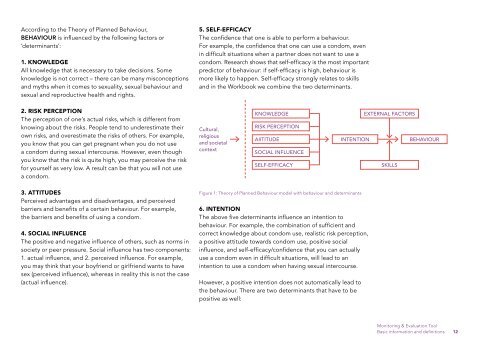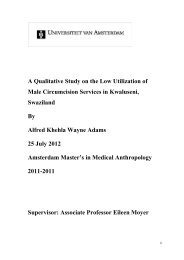ARE YOU ON THE RIGHT TRACK? - Rutgers WPF
ARE YOU ON THE RIGHT TRACK? - Rutgers WPF
ARE YOU ON THE RIGHT TRACK? - Rutgers WPF
- No tags were found...
Create successful ePaper yourself
Turn your PDF publications into a flip-book with our unique Google optimized e-Paper software.
According to the Theory of Planned Behaviour,BEHAVIOUR is influenced by the following factors or‘determinants’:1. KNOWLEDGEAll knowledge that is necessary to take decisions. Someknowledge is not correct – there can be many misconceptionsand myths when it comes to sexuality, sexual behaviour andsexual and reproductive health and rights.5. SELF-EFFICACYThe confidence that one is able to perform a behaviour.For example, the confidence that one can use a condom, evenin difficult situations when a partner does not want to use acondom. Research shows that self-efficacy is the most importantpredictor of behaviour: if self-efficacy is high, behaviour ismore likely to happen. Self-efficacy strongly relates to skillsand in the Workbook we combine the two determinants.2. RISK PERCEPTI<strong>ON</strong>The perception of one’s actual risks, which is different fromknowing about the risks. People tend to underestimate theirown risks, and overestimate the risks of others. For example,you know that you can get pregnant when you do not usea condom during sexual intercourse. However, even thoughyou know that the risk is quite high, you may perceive the riskfor yourself as very low. A result can be that you will not usea condom.Cultural,religiousand societalcontextKNOWLEDGEEXTERNAL FACTORSRISK PERCEPTI<strong>ON</strong>AIITITUDE INTENTI<strong>ON</strong> BEHAVIOURSOCIAL INFLUENCESELF-EFFICACYSKILLS3. ATTITUDESPerceived advantages and disadvantages, and perceivedbarriers and benefits of a certain behaviour. For example,the barriers and benefits of using a condom.4. SOCIAL INFLUENCEThe positive and negative influence of others, such as norms insociety or peer pressure. Social influence has two components:1. actual influence, and 2. perceived influence. For example,you may think that your boyfriend or girlfriend wants to havesex (perceived influence), whereas in reality this is not the case(actual influence).Figure 1: Theory of Planned Behaviour model with behaviour and determinants6. INTENTI<strong>ON</strong>The above five determinants influence an intention tobehaviour. For example, the combination of sufficient andcorrect knowledge about condom use, realistic risk perception,a positive attitude towards condom use, positive socialinfluence, and self-efficacy/confidence that you can actuallyuse a condom even in difficult situations, will lead to anintention to use a condom when having sexual intercourse.However, a positive intention does not automatically lead tothe behaviour. There are two determinants that have to bepositive as well:Monitoring & Evaluation ToolBasic information and definitions 12





